Fleas on dogs
If your dog is struggling to satisfy an itch, it could be a sign that they’ve become a tasty blood meal for fleas. Not only are fleas on dogs a nuisance, they can also carry diseases. Learn all you need to know about fleas and how you can treat your dog to stop an infestation in its tracks.
What are fleas?
Fleas are tiny wingless insects that feed on the blood of animals, including both pets and wildlife. Unfortunately, fleas love dogs and your pet may be bitten hundreds of times a day, which causes them to itch so desperately! They also bite humans but fleas don't actually live on humans in the same way they live on pets.
Why are fleas on dogs such a problem?

There are actually more than 2,000 different species of flea in the world but the most abundant and widespread is the cat flea, Ctenocephalides felis1.
Although cat fleas and dog fleas are two different species, they both feed on dogs and cats, and can leap as high as 50cm onto another host for their next feed.
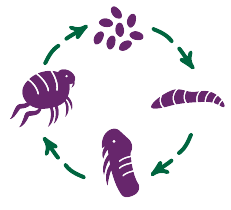
A single female flea can lay up to 50 eggs a day2, and its full life cycle – from egg, to larvae, to pupae, to adult – can take place in a matter of weeks.
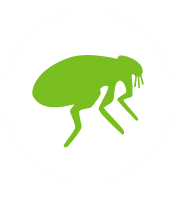
Most fleas live for two to three weeks before being groomed out by their host, but the maximum recorded life of a flea is 160 days!

Fleas breed rapidly in the warmth and humidity of late summer - but with modern central heating, fleas on dogs (and cats) can survive and thrive even in winter.
Fleas are expert hitchhikers and can easily be carried into the home on humans, animals (such as other pets including dogs and outdoor cats, or rodents), clothing and bags.
Flea bites are painful and itchy, and they can cause a range of additional problems including
- anaemia: multiple flea bites can lead to loss of blood, resulting in anaemia, which is particularly dangerous for flea-infested puppies, small breeds, elderly dogs and pregnant bitches, who may also be more vulnerable to heavy infestation
- Flea Allergic Dermatitis (FAD): this condition is an allergic reaction to flea saliva that irritates the skin and can cause intense itching in your dog
- tapeworms: if your dog ingests an infected flea they can catch tapeworm.
- diseases: infected fleas can pass on diseases to dogs when they bite. One study found that half of fleas carried at least one bacterial disease2
Find out more about the issues fleas can cause in both pets and humans.
How do dogs get fleas?
Fleas are a common problem and it is very easy for your dog to pick up fleas - but there are some simple measures you can take to reduce the risk of fleas hopping on to your dog:
1. From other animals
Dogs are sociable creatures and it is important for dogs to socialise with other dogs and pets for their wellbeing. However, fleas can jump from a dog they met in the park onto your dog. Similarly, on your daily walk, or even in your garden, your dog could come into contact with rodents, rabbits, squirrels, foxes, birds and deer - all of which might have fleas. As stated above, while the cat flea is more common than the dog flea, it isn't picky and will target dogs as well as cats - so quite often will hop from a pet cat onto a dog in a shared household.
2. From the home environment
Unfortunately, uninvited fleas can easily move into your home and make it their home too. If your dog visits friends' or relatives' houses, they could pick up fleas there and take them back home. Flea eggs can hitch a ride on people’s clothing before then falling off into the environment around them, dispersing into carpets and other warm, undisturbed areas such as bedding, soft toys, rugs and cushions. Adult fleas can also be carried by pets visiting you, and on nesting wild animals, such as mice that might have set up camp under your floorboards. They can lie dormant, particularly in carpets - so bear this in mind when moving into a property. If you drive your dog in your car, don't forget fleas can also move in here too!
3. Pet facilities
Indoor areas that other dogs visit can pose a risk of fleas for your pet. Fleas can be passed to your dog from other animals or from soft furnishings at a vet practice, doggy day care, grooming facilities or boarding kennels.
4. Warmer climates
If you’re travelling abroad with your dog, they will be exposed to different bugs and the diseases they carry. But in warmer regions, fleas are a particular risk because they are able to survive for longer periods in the open environment without a host, waiting to jump on your dog.
Fleas do best in warm weather, so most people think that fleas are only a risk during spring to early autumn. While this is peak season, you might be surprised to know that pets can also get fleas in the winter. This is because modern central heating creates the ideal conditions indoors for fleas to thrive. For this reason, it’s best to use flea protection on your pet all year round.
Signs of a flea infestation in dogs
Flea bites are painful and itchy. Your dog won’t be able to hide their discomfort; they'll attempt to relieve the itch by constantly scratching or licking at their irritated skin, which could lead to hair loss. This is often the first sign of an infestation, even if you haven’t actually seen a flea on your dog. This is because fleas burrow deep into an animal's fur coat and are often felt first before they’re seen. Signs your dog may have fleas include:
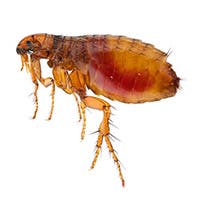
Fleas are about 2-6mm long, have thin flat bodies, and appear black, dark brown or reddish brown.
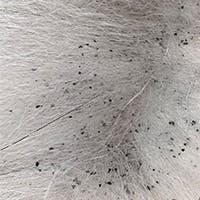
Dark specks on your dog's fur or skin or around the house, which look a bit like ground black pepper, could be 'flea dirt' - the faecal matter of fleas and consists of undigested blood.
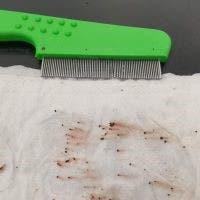
Use a flea comb, particularly on the neck, tummy, tail base and back legs. Shake the fur caught on the comb onto a damp piece of white tissue to easily see fleas or flea dirt - the dirt will stain the paper red from undigested blood.

You may notice that your dog is scratching more than normal

Overzealous or prolonged licking, biting and chewing that can lead to bald patches, sparse and damaged fur.
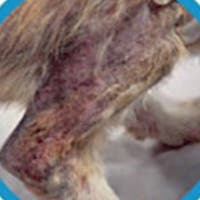
Scabs and red, sore areas on your dog's skin due to scratching and overgrooming could indicate they have an allergy to flea bites.
Fleas can cause serious skin disease in dogs, so if you are worried that your dog has patchy fur or painful looking skin, or seems generally unwell, then get your vet to check them over.
Find out more about how to spot the signs of fleas on dogs
How to treat dogs for fleas
Fleas can have a serious impact on your dog’s health and quality of life. It’s also important not to underestimate the impact they can have on you and your home, leading to flea infestations. If this happens, it can take weeks and even months to be totally rid of fleas.
Rather than restrict contact with other pets, the easiest and most effective way to protect your dog from fleas is to use a flea treatment regularly. There are many different options available, including:

Flea collars can vary in how they work; Seresto Flea and Tick Control collar for dogs kills fleas (and repels and kills ticks) through contact without the need for them to bite your pet3. Just put it on your dog like a normal collar and with Seresto they’re protected for 7-8 months.

Spot-on dog flea treatments, such as Advantage Spot-on, contain a small amount of liquid that is applied to the skin between the dog's shoulder blades once a month. Many pet owners find them convenient as they are easy to apply. Advantage Spot-on kills fleas within 24 hours and prevents further infestations for 4 weeks. Fleas are killed through contact with the treated pet and do not have to bite to die3.

Tablets are another commonly used method to protect dogs from fleas and can be given either by putting the tablet in with your pet's food or treats, or by gently giving it directly into their mouth. An example of a tablet available for preventative flea control is Advantage Chewable. This a tasty, meat-flavoured chewable tablet that provides fast-acting, reliable protection, killing fleas in just 4 hours and ticks in 8 hours4. If your dog already has an infestation of fleas, one Capstar tablet starts killing adult fleas in just 15-30 minutes and lasts 24 hours; to prevent a re-infestation of fleas, you'll need to use a longer-acting preventative product afterwards too.
In addition to killing adult fleas, flea treatments will usually interrupt the flea life cycle by killing them before they have a chance to lay eggs around your home. Some products have a direct effect on the immature flea stages.
When treating your dog, you’ll need to apply a flea treatmet to all pets in the household to minimise the chances of an infestation. You can also reduce the risk of your dog catching fleas from wild animals by keeping rubbish bags in a wheelie bin, so as not to attract any hungry foxes or rodents.
Flea Treatment Product Options
Whenever applying flea treatments, always make sure you read the label and consult your vet if you’re unsure. They will be able to advise you on the best product and dose for your dog’s age and weight.
Don’t forget about worms
Fleas can carry the tapeworm parasite, a nasty intestinal worm which can be transmitted to your dog if ingested. It’s recommended dogs are wormed alongside flea control for full coverage. Speak to your vet about treatment options and frequency.
Treating your house
A crucial part of de-fleaing is treating the house: only around 5% of fleas in an infestation are found on your pet – the other 95% will be scattered all around your home in immature stages.
- Wash your dog's bedding and toys – remove any fur from the bedding before washing and dispose of it in general waste, then always wash the bedding on a hot wash, ideally at 50˚C or above, as the high temperature will kill the fleas and their eggs which may be hiding there. Try drying it using heat, such as in a tumble dryer, rather than air drying.
- Wash your own bedding too, especially if your dog sleeps on your bed!
- Vacuum thoroughly – vacuum all floors, carpets, rugs and sofas and remember to empty your machine to stop flea eggs hatching inside.
- Other treatments – speak to your vet about other treatments that can be used if you have a home infestation. Don't forget to treat other pets in the house or garden at the same time.
Fleas can be hard work to get rid of once they’ve moved in, so save yourself the time and energy by avoiding an infestation in the first place by using a regular flea treatment.
- Lance A. Durden, Nancy C. Hinkle, Fleas (Siphonaptera) in Medical and Veterinary Entomology (Third Edition), 2019
- ESCCAP
- Mehlhorn et al. Parasitol Res (2001) 87:198-207, information is regarding mode of action and is not intended to relate to speed of kill or to imply parasites can be completely stopped from biting.
- Advantage Chewable Summary of Product Characteristics.

